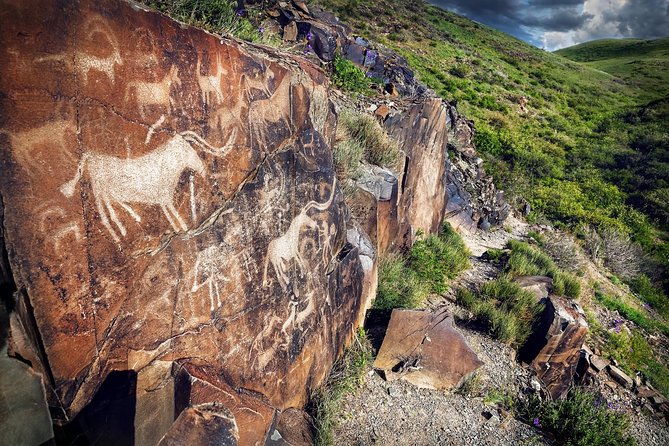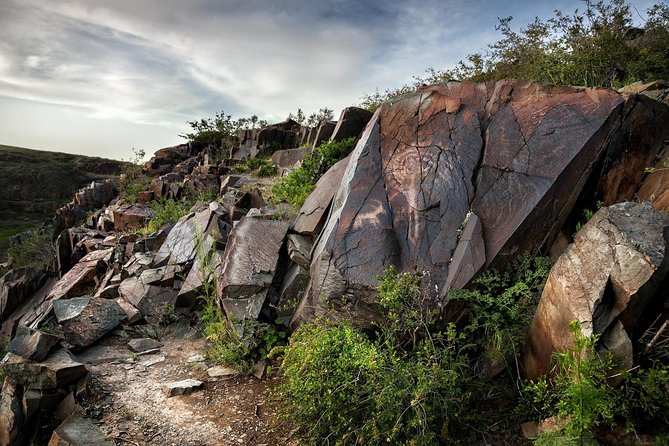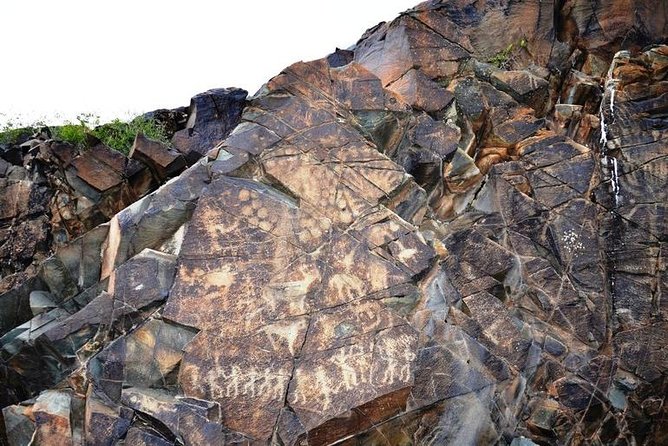The ancient petroglyphs of Tanbaly in Kazakhstan’s Almaty region offer a captivating window into the past. This UNESCO World Heritage site showcases a remarkable collection of rock carvings spanning from the Bronze Age to the medieval era. These intricate artworks reveal much about the lives, beliefs, and cultural practices of early civilizations, from hunting scenes to symbolic spiritual rituals. Visitors can explore this unique archaeological treasure and gain a deeper understanding of humanity’s shared history. But the true allure of Tanbaly lies in the stories these ancient petroglyphs have yet to tell.
Good To Know

- The Tanbaly Archaeological Site in Kazakhstan is part of a UNESCO World Heritage site, featuring a collection of ancient petroglyphs from the Bronze Age to the 13th-14th centuries.
- The petroglyphs at Tanbaly offer insights into the lives, beliefs, and cultural practices of the ancient inhabitants, showcasing their artistic abilities and ingenuity.
- The petroglyphs depict a diverse range of motifs, including hunting scenes, pastoral activities, shamanic symbols, and astrological imagery, reflecting the evolution of the region’s cultural and spiritual beliefs.
- Visitors can explore the Tanbaly site through a guided tour, which provides in-depth information about the petroglyphs and their historical significance, as well as the opportunity to witness the site’s natural beauty.
- The Tanbaly Archaeological Site is a renowned cultural heritage destination, drawing visitors who are interested in exploring the region’s rich history and engaging with its artistic legacy.
Overview of the Tanbaly Archaeological Site

The Tanbaly archaeological site, situated within the Almaty region of Kazakhstan, is part of a UNESCO World Heritage site that showcases an impressive collection of ancient petroglyphs.
The Tamgaly museum-reserve features an archaeological complex with petroglyphs spanning from the Bronze Age to the 13th-14th centuries.
These petroglyphs, carved into the rock surfaces, offer a glimpse into the lives and beliefs of the people who inhabited the region centuries ago.
The site’s significance lies in the diversity and well-preserved state of the rock art, providing valuable insights into the cultural heritage of this remarkable region.
Fascinated by Almaty's past? More historical tours we've covered
Significance of the Petroglyphs

At the Tanbaly archaeological site, the ancient petroglyphs hold immense significance, revealing the cultural and spiritual traditions of the people who inhabited this region centuries ago. The petroglyphs, spanning from the Bronze Age to the 13th-14th centuries, depict a rich tapestry of human experiences, from hunting scenes to religious rituals. These rock carvings serve as a gateway to the past, allowing visitors to glimpse the lives and beliefs of bygone eras. The following table showcases the diversity of the Tanbaly petroglyphs:
| Era | Dominant Motifs | Significance |
|---|---|---|
| Bronze Age | Hunting, pastoral scenes | Insights into subsistence activities |
| Early Iron Age | Warrior figures, horse depictions | Reflections of social structure, warfare |
| Medieval Period | Shamanic symbols, astrological motifs | Glimpses of spiritual and religious practices |
Exploring the Bronze Age Carvings
As visitors explore the Tanbaly petroglyphs, they uncover a captivating window into the Bronze Age, where hunting and pastoral scenes dominate the rock carvings.
The earliest petroglyphs date back to the Bronze Age, showcasing the intricate artistic abilities of the region’s ancient inhabitants.
Intricate depictions of horseback riders, deer, and various other animals provide insight into the daily lives and cultural practices of these early civilizations.
The petroglyphs serve as a remarkable testament to the ingenuity and creativity of the people who inhabited this region thousands of years ago, inviting visitors to appreciate the rich history preserved within the Tanbaly museum-reserve.
Symbols and Imagery of the Medieval Era

Alongside the Bronze Age carvings, the Tanbaly museum-reserve showcases a diverse array of petroglyphs dating back to the Medieval era. These enigmatic rock carvings depict a rich tapestry of symbols and imagery, offering a glimpse into the lives and beliefs of the people who inhabited the region centuries ago. The medieval petroglyphs include:
| Imagery | Symbolism |
|---|---|
| Hunting scenes | Religious iconography |
| Pastoral activities | Geometric patterns |
| Celestial bodies | Anthropomorphic figures |
These evocative etchings on the rock surface provide a captivating window into the cultural and spiritual practices of the medieval population, inviting visitors to ponder the stories they hold and the connections they forge across the ages.
Guided Tour Highlights
The guided tour of the Tanbaly petroglyphs offers visitors an immersive experience exploring the site’s ancient rock carvings.
The tour begins with a 2.5-hour drive from Almaty, taking guests to the Tamgaly museum-reserve, a UNESCO World Heritage site. Knowledgeable guides lead the way, providing in-depth information about the petroglyphs, which date back to the Bronze Age and the 13th-14th centuries.
Visitors can expect to see various groups of petroglyphs, each showcasing a different era. The tour lasts 3 hours, and transportation, bottled water, and lunch options are available.
While the experience isn’t wheelchair accessible, it’s suitable for travelers with moderate physical fitness.
Getting to the Tanbaly Museum-Reserve
To reach the Tanbaly museum-reserve, visitors can embark on a 2.5-hour drive from Almaty city center.
The tour includes pickup from any hotel, hostel, or apartment in the city center, providing convenient transportation.
The private tour is conducted in an air-conditioned vehicle, ensuring a comfortable journey.
Bottled water is provided, and lunch options are available for those who wish to enjoy a meal during the experience.
The tour lasts approximately 3 hours, including the time spent exploring the archaeological complex and its impressive collection of petroglyphs.
Free cancellation is available up to 24 hours before the start of the tour, offering flexibility for travelers.
Preparing for the Tanbaly Adventure
With the Tanbaly museum-reserve awaiting, visitors should ensure they’re prepared for the adventure. The tour involves moderate physical activity, so comfortable walking shoes are a must. To beat the heat, sun protection and hydration are key. Plus, visitors should bring their cameras to capture the stunning petroglyphs and the breathtaking natural surroundings.
| Packing Essentials | Why |
|---|---|
| Comfortable Shoes | For the moderate walking |
| Sun Protection | To shield from the sun |
| Water Bottle | To stay hydrated |
| Camera | To document the experience |
The Tanbaly adventure promises an immersive cultural experience, but proper preparation will ensure visitors make the most of their journey.
Traveler Testimonials and Recommendations
Travelers from near and far have left enthusiastic reviews of their Tanbaly experience.
With a perfect 5-star rating, visitors praise the expert guides who bring the ancient petroglyphs to life through engaging discussions. Nursultan, in particular, is singled out for his extensive knowledge and excellent English skills.
Travelers highlight the tour’s educational value, appreciating the opportunity to learn about the different eras represented in the rock art. Despite the moderate physical requirements, visitors find the overall experience pleasant and rewarding.
Whether you’re an archaeology enthusiast or simply seeking a unique cultural adventure, the Tanbaly petroglyphs promise an unforgettable journey through Kazakhstan’s captivating past.
Frequently Asked Questions
How Well-Preserved Are the Ancient Petroglyphs at Tanbaly?
The petroglyphs at Tanbaly are remarkably well-preserved, allowing visitors to observe detailed rock carvings dating back to the Bronze Age and later periods. The site’s isolation and limited development have helped protect these ancient artworks over the centuries.
Can Visitors Touch or Rub the Petroglyphs During the Tour?
Visitors are not allowed to touch or rub the petroglyphs during the tour. The guides strictly enforce this rule to preserve the fragile rock carvings. Touching the petroglyphs could damage the delicate artwork and is strictly prohibited.
Is Photography Allowed at the Tanbaly Archaeological Site?
Photography is allowed at the Tanbaly archaeological site. Visitors can take pictures of the petroglyphs, but they’re advised not to touch or rub them to preserve the ancient rock carvings.
Are There Any Safety Precautions Visitors Should Be Aware Of?
Visitors should wear comfortable shoes, bring sun protection, and stay on designated paths. The terrain can be uneven, and the site doesn’t have wheelchair access. Guides provide safety instructions to ensure an enjoyable and secure experience.
Can the Tour Be Customized for Specific Interests or Needs?
Yes, the Tanbaly petroglyphs tour can be customized to accommodate specific interests or needs. The tour operator offers flexibility to tailor the experience, such as adjusting the itinerary or providing additional information on areas of particular interest to visitors.
Sum Up
The Ancient Petroglyphs of Tanbaly are a remarkable UNESCO World Heritage site that offers a captivating window into the lives and beliefs of early civilizations. From Bronze Age hunting scenes to medieval spiritual symbols, these intricate carvings provide a vital link to humanity’s past, inspiring visitors to explore and appreciate this remarkable cultural treasure. The Tanbaly museum-reserve ensures the preservation and accessibility of this historic site for generations to come.
More Tour Reviews in Almaty
Not for you? Here's more things to do in Almaty we have recnetly reviewed
- 2 Best Guided Tours In Almaty
- 15 Best 2 Day Tours In Almaty
- 7 Best 3 Day Tours In Almaty
- Best Shopping Tours In Almaty
- Best Lunch Experiences In Almaty
- 3 Best 4 Day Tours In Almaty
- 2 Best Food Tours In Almaty
- 4 Best Full-Day Tours In Almaty
- Private Transfer From Almatý (Ala) Airport to Almatý City
- Charyn Canyon Private Tour
- Primeval Beauty of Altyn-Emel National Park (2 Days)
- 5 Hours Private City Tour Inclusive Kok Tobe
